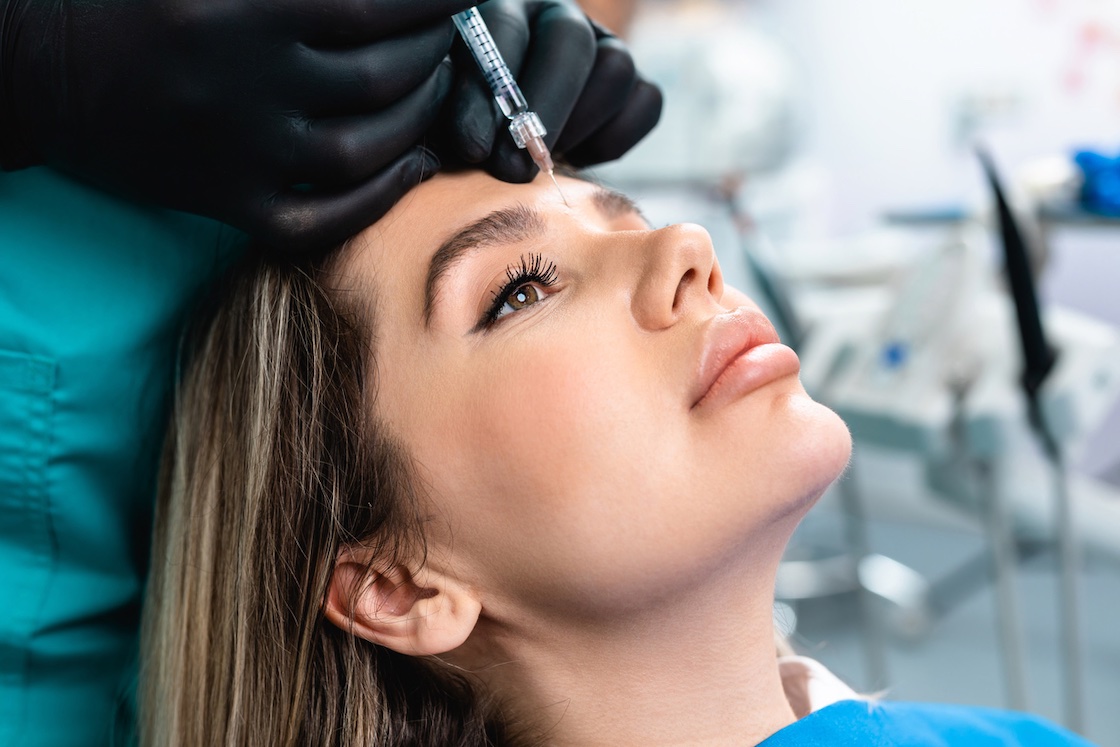Although Botox falls under the category of “injectables,” there are some important differences between it and other treatments like facial fillers.
For one, dermal fillers—which Botox is not—typically use the active ingredient of hyaluronic acid to “fill in” lines and wrinkles. In contrast, Botox affects underlying facial muscle movement to prevent wrinkles from forming in the first place, or to reduce those already present.
Table of Contents
What is Botox?
Botox is an injectable product containing a liquid used for the treatment of:
- Frown lines
- Crow’s feet
- Smile and squint lines
- Horizontal forehead wrinkles
In addition to its cosmetic uses, Botox is frequently used to help prevent or minimize migraine headaches. It is also used for the treatment of a condition called hyperhidrosis, or excessive sweating.
Botox has been safely used for over two decades. It contains a type of bacterium known as “clostridium botulinum.” Before it is used for treatment, the product is purified within a tightly controlled medical facility.
How Botox Works
To fully understand how Botox works in cosmetic applications, it is useful to learn what causes certain types of deep facial wrinkles, such as those commonly found on the forehead or between the eyebrows. Wrinkles like these are somewhat different than the more superficial type that involves structural changes to the skin.
“Dynamic wrinkles” tend to be very prominent lines and creases, which are formed by the contraction of facial muscles. What Botox does is reduce the activity of these muscles to prevent them from contracting and forming dynamic wrinkles.
Botox Procedure
If you’re squeamish about possible pain from Botox injections, don’t be. Your provider can apply a topical anesthetic before injecting the product to ensure your comfort. They will be using only a very fine needle that results in very little pain or discomfort.
The Botox product itself should not be expected to cause any inflammation or irritation. All that most people experience is a very minor stinging sensation when the injections are administered.
After receiving your Botox injections, you are free to return home immediately. You can safely drive yourself home, but you may want to make arrangements for someone else to drive you, to ease your mind.
Patients will be advised to avoid certain things immediately after Botox is administered.
Botox Results
Although you may experience some fairly immediate effects from your Botox injections, it may take a bit longer for you to notice full results. It is not uncommon to begin noticing effects within 72 hours, although it may take as long as one week to achieve maximum effects.
Your provider may ask you to return after your Botox injections to assess your response. Some people only receive a partial response from their first set of injections. This is not unusual, and complete relaxation of facial muscles may sometimes only be achieved following the second or third treatment.
For most people, Botox delivers satisfying results. But it is important to realize that this is not a permanent treatment. At some point, typically three or four months, the movement of your injected facial muscles will start to return. You would need follow-up injections at that point to maintain your results.
Botox for Migraine Relief
Botox helps treat migraine headaches by minimizing muscle contractions and stopping the ability of neurotransmitters from delivering pain signals to the brain. This reduces migraine headache pain and allows many patients to enjoy their lives without frequent interruptions.
The effects of Botox for migraines is, unfortunately, not as long-lasting as it is for wrinkle reduction, so patients must receive frequent injections to control their headaches. Most migraine patients receive Botox injections about every 12 weeks. It can take a few weeks after receiving injections to experience migraine relief. Your doctor may adjust your injection frequency to suit your individual needs.
On the plus side, some patients may be able to get Botox covered by health insurance, if used for migraine relief and other medical conditions.
Eligible Candidates
Not everyone who suffers from migraines makes an appropriate patient for Botox therapy.
This treatment is only recommended for those meeting the following criteria:
- Are a minimum of 18 years old
- Have been struggling with treatable migraines for at least three months
- Have migraine headaches more than 15 days a month, with migraine headaches lasting a minimum of four hours
Hyperhidrosis Treatment
Excessive sweating, medically known as hyperhidrosis, can also be treated by Botox injections. The most common area treated with Botox are the armpits, but the palms of the hands and soles of the feet are also treated effectively with injections. Patients find that the amount of sweat that their bodies produce in these areas is significantly reduced, making Botox a real lifesaver, particularly during the hot summer months.


